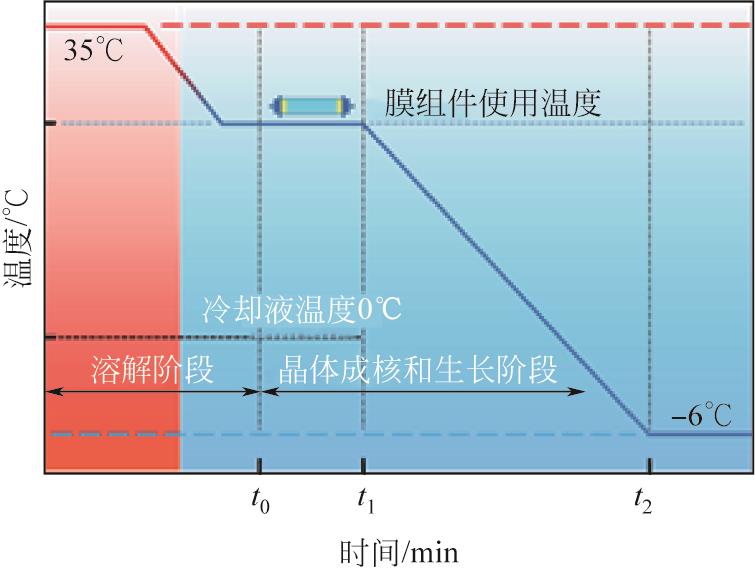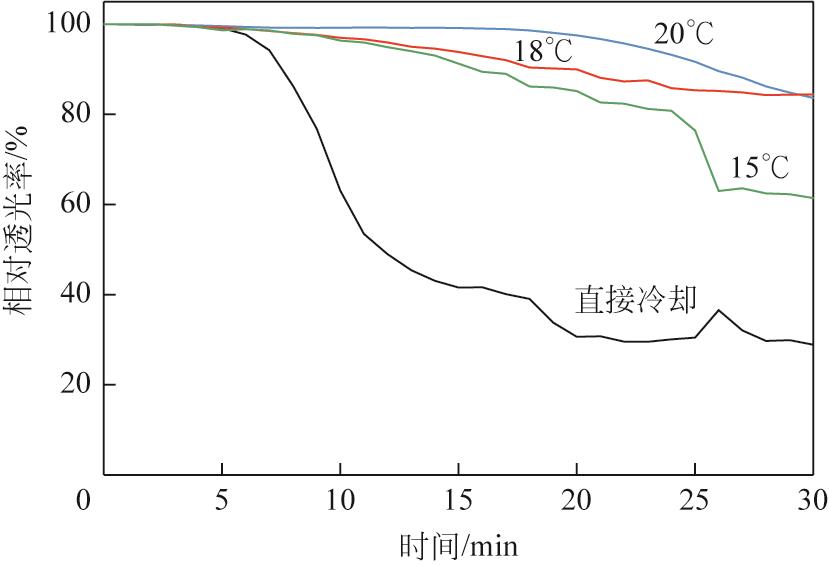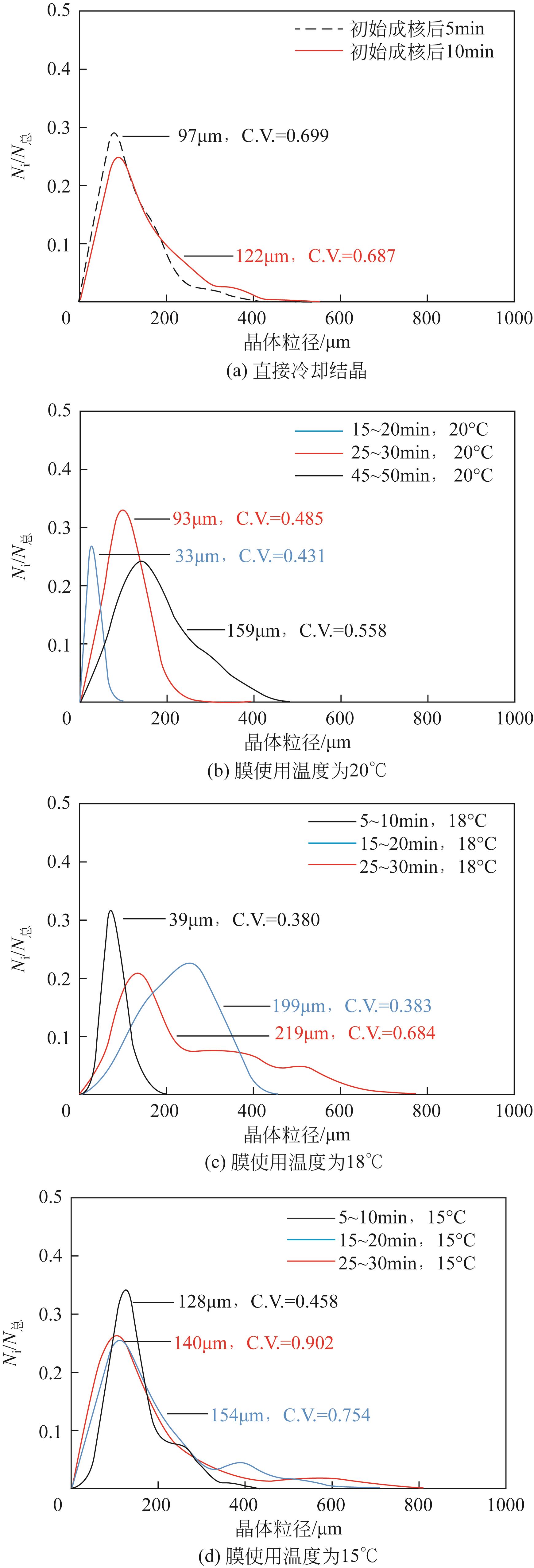| 1 |
MULLIN J W. Crystallization[M]. 4th ed. Moburn: Butterworth Heinemann, 2001: 92-98.
|
| 2 |
李盼. 冷却结晶制备高纯车用尿素过程研究[D]. 大连: 大连理工大学, 2017.
|
|
LI Pan. Research on the cooling crystallization process for hyperpure adblue preparation[D]. Dalian: Dalian University of Technology, 2017.
|
| 3 |
郭雪梅, 王少娜, 杜浩, 等. 碳酸氢铵溶液中偏钒酸铵的冷却结晶[J]. 化工进展, 2018, 37(3): 853-860.
|
|
GUO Xuemei, WANG Shaona, DU Hao, et al. Cooling crystallization of ammonium metavanadate from ammonium bicarbonate solution[J]. Chemical Industry and Engineering Progress, 2018, 37(3): 853-860.
|
| 4 |
MYERSON Allan S. Handbook of industrial crystallization[M]. 2nd ed. Boston: Butterworth Heinemann, 2002: 127-136.
|
| 5 |
LIU J J, MA C Y, WANG X Z. Imaging protein crystal growth behaviour in batch cooling crystallisation[J]. Chinese Journal of Chemical Engineering, 2016, 24(1): 101-108.
|
| 6 |
BROWN C J, MCGLONE T, YERDELEN S, et al. Enabling precision manufacturing of active pharmaceutical ingredients: workflow for seeded cooling continuous crystallisations[J]. Molecular Systems Design & Engineering, 2018, 3(3): 518-549.
|
| 7 |
李康. 溶液结晶中晶习控制与优化研究[D]. 天津: 天津大学, 2020.
|
|
LI Kang. Study on the control and optimization of crystal habits in the process of solution crystallization[D]. Tianjin: Tianjin University, 2020.
|
| 8 |
UNNO J, HIRASAWA I. Partial seeding policy for controlling the crystal quality in batch cooling crystallization[J]. Chemical Engineering & Technology, 2020, 43(6): 1065-1071.
|
| 9 |
ZHANG Fangkun, SHAN Baoming, WANG Yinglong, et al. Progress and opportunities for utilizing seeding techniques in crystallization processes[J]. Organic Process Research & Development, 2021, 25(7): 1496-1511.
|
| 10 |
KACKER R, SALVADOR P M, STURM G S J, et al. Microwave assisted direct nucleation control for batch crystallization: crystal size control with reduced batch time[J]. Crystal Growth & Design, 2016, 16(1): 440-446.
|
| 11 |
KAUR BHANGU S, ASHOKKUMAR M, LEE J. Ultrasound assisted crystallization of paracetamol: crystal size distribution and polymorph control[J]. Crystal Growth & Design, 2016, 16(4): 1934-1941.
|
| 12 |
PRASAD R, DALVI S V. Sonocrystallization: monitoring and controlling crystallization using ultrasound[J]. Chemical Engineering Science, 2020, 226: 115911.
|
| 13 |
LÜHRMANN M C, TERMÜHLEN M, TIMMERMANN J, et al. Induced nucleation by gassing and its monitoring for the design and operation of an MSMPR cascade[J]. Chemical Engineering Science, 2018, 192: 840-849.
|
| 14 |
CHARCOSSET C, KIEFFER R, MANGIN D, et al. Coupling between membrane processes and crystallization operations[J]. Industrial & Engineering Chemistry Research, 2010, 49(12): 5489-5495.
|
| 15 |
JIANG Xiaobin, Linghan TUO, LU Dapeng, et al. Progress in membrane distillation crystallization: process models, crystallization control and innovative applications[J]. Frontiers of Chemical Science and Engineering, 2017, 11(4): 647-662.
|
| 16 |
JIANG Xiaobin, LI Guannan, LU Dapeng, et al. Hybrid control mechanism of crystal morphology modification for ternary solution treatment via membrane assisted crystallization[J]. Crystal Growth & Design, 2018, 18(2): 934-943.
|
| 17 |
SPARENBERG M C, CHERGAOUI S, SANG SEFIDI V, et al. Crystallization control via membrane distillation-crystallization: a review[J]. Desalination, 2021, 519: 115315.
|
| 18 |
DI PROFIO G, STABILE C, CARIDI A, et al. Antisolvent membrane crystallization of pharmaceutical compounds[J]. Journal of Pharmaceutical Sciences, 2009, 98(12): 4902-4913.
|
| 19 |
盛磊, 脱凌晗, 姜晓滨, 等. 有机膜精确调控传质的新型溶析结晶及过程强化[J]. 化工进展, 2020, 39(5): 1692-1700.
|
|
SHENG Lei, Linghan TUO, JIANG Xiaobin, et al. Novel antisolvent crystallization and process intensification via the accurate mass transfer control of the organic membrane[J]. Chemical Industry and Engineering Progress, 2020, 39(5): 1692-1700.
|
| 20 |
LI Jin, SHENG Lei, Linghan TUO, et al. Membrane-assisted antisolvent crystallization: interfacial mass-transfer simulation and multistage process control[J]. Industrial & Engineering Chemistry Research, 2020, 59(21): 10160-10171.
|
| 21 |
Linghan TUO, RUAN Xuehua, XIAO Wu, et al. A novel hollow fiber membrane-assisted antisolvent crystallization for enhanced mass transfer process control[J]. AIChE Journal, 2019, 65(2): 734-744.
|
| 22 |
SONG Liming, LI Baoan, ZARKADAS D, et al. Polymeric hollow-fiber heat exchangers for thermal desalination processes[J]. Industrial & Engineering Chemistry Research, 2010, 49(23): 11961-11977.
|
| 23 |
FENG Shasha, ZHONG Zhaoxiang, WANG Yong, et al. Progress and perspectives in PTFE membrane: preparation, modification, and applications[J]. Journal of Membrane Science, 2018, 549: 332-349.
|
| 24 |
PETUKHOV D I, KOMKOVA M A, BROTSMAN V A, et al. Membrane condenser heat exchanger for conditioning of humid gases[J]. Separation and Purification Technology, 2020, 241: 116697.
|
| 25 |
CHEN Dengyue, SINGH D, SIRKAR K K, et al. Continuous preparation of polymer coated drug crystals by solid hollow fiber membrane-based cooling crystallization[J]. International Journal of Pharmaceutics, 2016, 499(1/2): 395-402.
|
| 26 |
XIAO Wu, HE Zeman, SHAO Guanying, et al. Membrane-assisted cooling crystallization for interfacial nucleation induction and self-seeding control[J]. Industrial & Engineering Chemistry Research, 2022, 61(1): 765-776.
|
| 27 |
LI Pan, HE Gaohong, LU Dapeng, et al. Crystal size distribution and aspect ratio control for rodlike urea crystal via two-dimensional growth evaluation[J]. Industrial & Engineering Chemistry Research, 2017, 56(9): 2573-2581.
|
| 28 |
ZHOU G, MOMENT A, CUFF J, et al. Process development and control with recent new FBRM, PVM, and IR[J]. Organic Process Research & Development, 2014, 19(1): 315-319.
|
| 29 |
SIMONE E, SALEEMI A N, NAGY Z K. Raman, UV, NIR, and mid-IR spectroscopy with focused beam reflectance measurement in monitoring polymorphic transformations[J]. Chemical Engineering & Technology, 2014, 37(8): 1305-1313.
|
| 30 |
KADAM S S, VAN DER WINDT E, DAUDEY P J, et al. A comparative study of ATR-FTIR and FT-NIR spectroscopy for in situ concentration monitoring during batch cooling crystallization processes[J]. Crystal Growth & Design, 2010, 10(6): 2629-2640.
|
| 31 |
AGHAJANIAN S, RUUSKANEN V, NIEMINEN H, et al. Real-time monitoring and insights into process control of micron-sized calcium carbonate crystallization by an in-line digital microscope camera[J]. Chemical Engineering Research and Design, 2022, 177: 778-788.
|
| 32 |
郭盛争, 吴送姑, 苏鑫, 等. 莱鲍迪苷A溶解度与介稳区宽度的测定及其结晶过程研究[J]. 化工学报, 2021, 72(8): 3997-4008.
|
|
GUO Shengzheng, WU Songgu, SU Xin, et al. Determination of solubility and metastable zone width of rebaudioside A and study on its crystallization process[J]. CIESC Journal, 2021, 72(8): 3997-4008.
|
| 33 |
LI Da, QI Tao, GAO Yiying. Crystallization of ammonium persulfate in the presence of an additive: experimental and molecular dynamics simulation studies[J]. Crystal Research and Technology, 2018, 53(3): 1700280.
|
| 34 |
王超. 离子交换膜电解制取过硫酸铵的研究[D]. 北京: 北京化工大学, 2019.
|
|
WANG Chao. Study on electrosynthesis of ammonium persulfate by ion exchange membranes[D]. Beijing: Beijing University of Chemical Technology, 2019.
|
| 35 |
郭林. 邻苯二甲酸的溶解度测定及其神经网络模拟[D]. 郑州: 郑州大学, 2005.
|
|
GUO Lin. Determination of solubility of ο-phthalic acid and the simulation with neural network[D]. Zhengzhou: Zhengzhou University, 2005.
|
| 36 |
魏婷. 过硫酸铵连续结晶器流场模拟[D]. 西安: 西安石油大学, 2015.
|
|
WEI Ting. Flow field simulation of ammonium persulfate continuous crystallizer[D]. Xi’an: Xi’an Shiyou University, 2015.
|
| 37 |
殷萍. 硫酸铵蒸发结晶过程研究[D]. 天津: 天津大学, 2007.
|
|
YIN Ping. Study on evaporation crystallization process of ammonium sulfate[D]. Tianjin: Tianjin University, 2007.
|
| 38 |
GHADERZADEH K. Crystal wet milling in rotor-stator mixers[D]. Maryland State: University of Maryland, 2018.
|
 ), HE Gaohong, JIANG Xiaobin(
), HE Gaohong, JIANG Xiaobin( )
)










